- Joined
- Oct 1, 2007
- Messages
- 13,589
- Reaction score
- 9,940
- Website
- www.africahunting.com
- Media
- 5,597
- Articles
- 321
His Imperial Majesty's Shoot, Nepal 1911

The Album
The album consists of 16 pages and 50 photographs. It appears incomplete with the back cover missing. The front cover bears the company name Herzog & Higgins, Mhow (Central India) and the words "Bound at the Caxton Works, Bombay" inside the front cover. The album was discovered in a rural Indian home in Madhya Pradesh by the donor, Dr U.N. Bhati, Visiting Fellow, Economics and Marketing, School of Resources, Environment and Society at The Australian National University. The album was given to Dr Bhati by a distant relative who had worked for the former Maharaja and Maharani of Ratlam (in Madhya Pradesh), Mr and Mrs Parbinder Singh - who had given him the album.
About the Photographs
These 50 photographs depict scenes of the shikar, or hunt, the hunted animals and the hunting camps of King George V in the Tarai in December 1911. The photographs feature the wild animals of the Tarai including tigers, bears and rhinoceroses, the use of the elephant "hunting ring" technique, the activities of the mahouts (or elephant trainers/handlers) and shikaris (or hunters) as well as the various dignitaries involved in the visit. Each individual photograph has a pencilled number, but no caption. The captions have been supplied by the ANU Library.
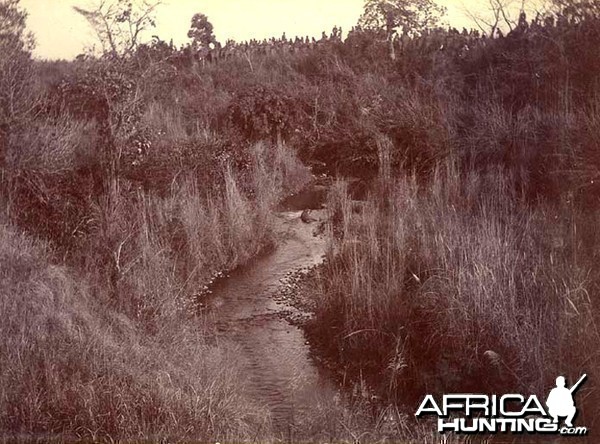
Tiger lying in a stream. A tiger lies in a stream, with the ring of elephants in view in the background. The "ring" is a method of hunting peculiar to Nepal. The hunters mounted on elephants form a "ring" and move in on their quarry, which has previously been stalked and enclosed in the area surrounded by the ring. [On the first day of the hunt, 18th December] "... the first tiger [was] shot by His Majesty in mid-air as it was leaping a small stream." Historical record of the Imperial visit to India, 1911, p. 230.
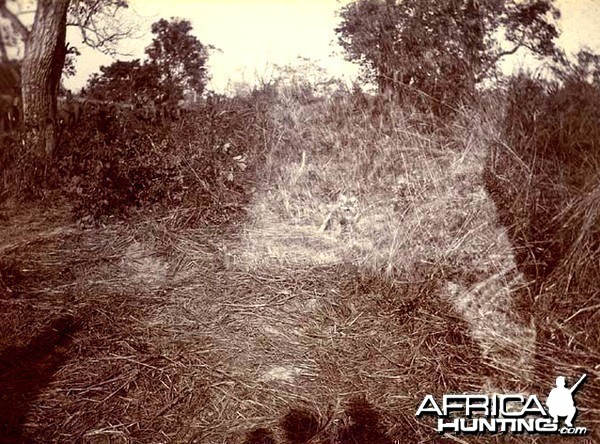
Tiger. The tiger is camouflaged in the grassland. There are ominous shadows in the foreground.

George V with hunting party in the forest. George V stands in his howdah.

Hunting party inspects the head of a slain rhinoceros. There were a total of 18 rhinoceroses killed during this hunt.

Hunting party on elephants fording a river. River is probably the Rapti. The hunting parties camped on the banks of this river during the hunt.
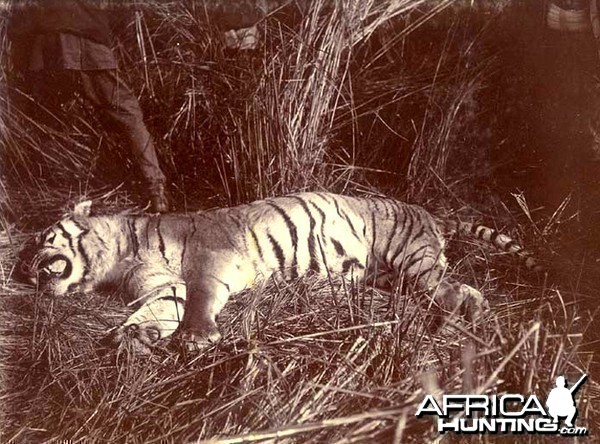
Slain tiger. There were a total of 39 tigers killed during this hunt.
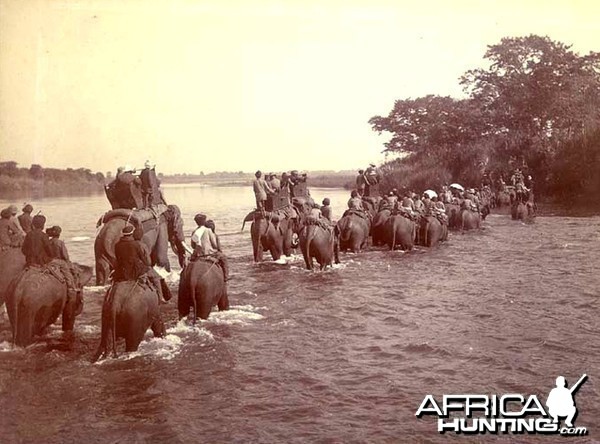
Hunting party on elephants fording a river. River is probably the Rapti. The hunting parties camped on the banks of this river during the hunt.

Hunting party on elephants fording a stream.
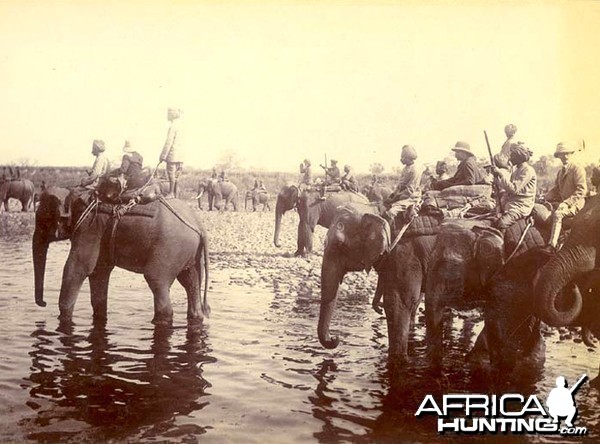
Hunting party on elephants at the edge of a river. River is probably the Rapti. The hunting parties camped on the banks of this river during the hunt.

Tiger crossing a stream. Historical record of the Imperial visit to India, 1911, p.230, notes that [on the first day of the hunt, 18th December] " ... the first tiger [was] shot by His Majesty in mid-air as it was leaping a small stream." There were a total of 39 tigers killed during this hunt.
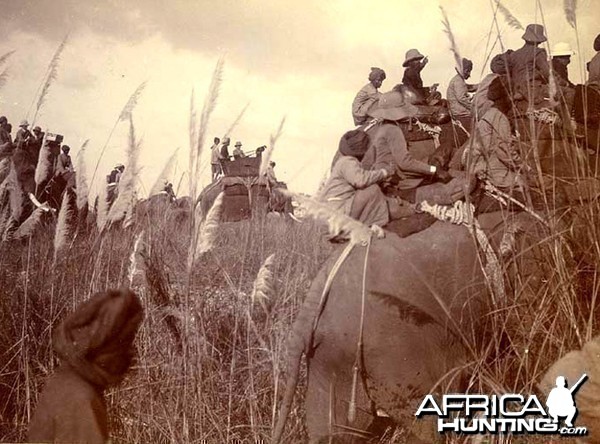
Hunting party on elephants. The hunting party on elephants moves through long grass. King George V, on the right, is mounted on an elephant without a howdah.
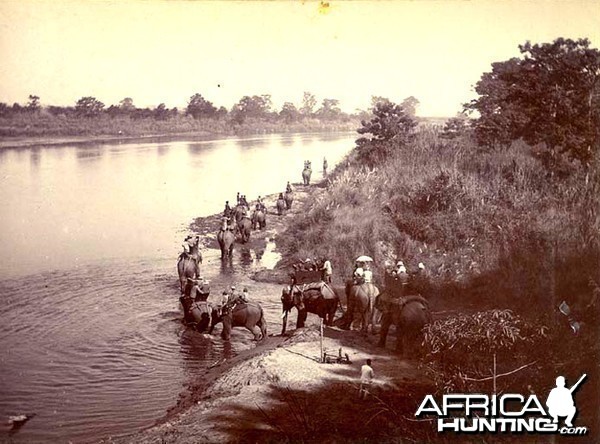
Hunting party on elephants skirting a river. River is probably the Rapti. The hunting parties camped on the banks of this river during the hunt.

Hunting party with elephants. Members of George V's hunting party walk towards the waiting elephants and mahouts.
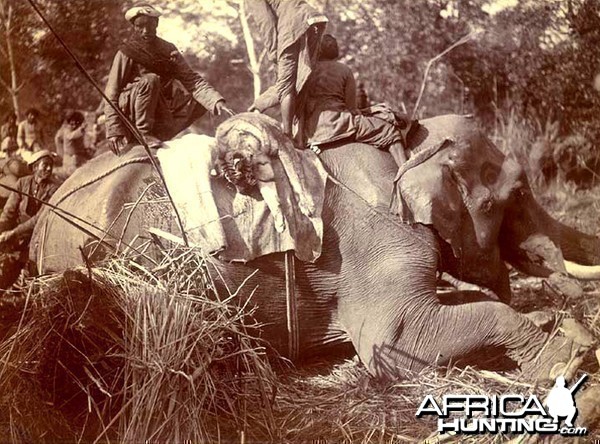
Slain tiger on the back of an elephant. Shikaris load a dead tiger onto the back of a seated elephant. There were a total of 39 tigers killed during this hunt.

Rhinoceros (and tiger?). Grassland with a rhinoceros at the left, and possibly a tiger at the bottom right.
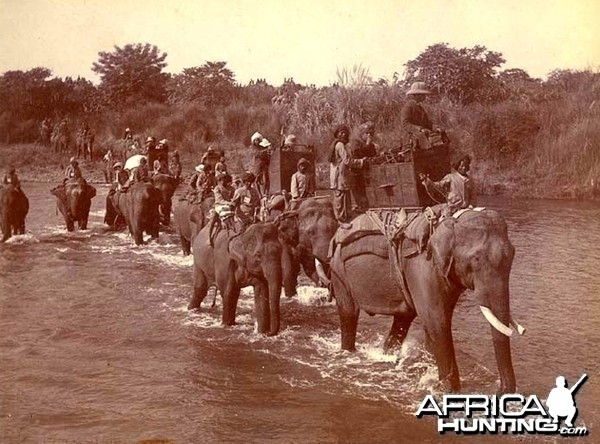
Hunting party on elephants fording a river. River is probably the Rapti. The hunting parties camped on the banks of this river during the hunt.
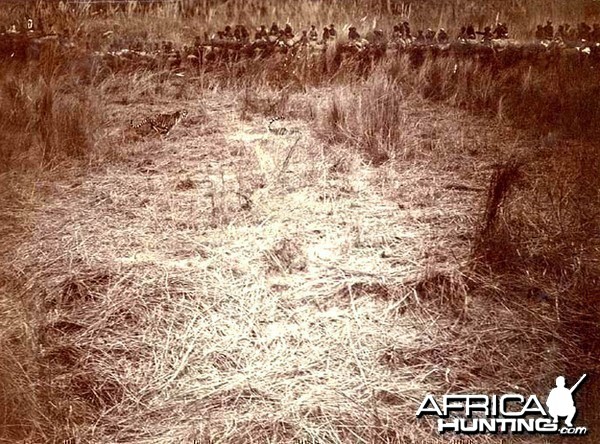
Tigers running surrounded by the "ring" of elephants. The "ring" is a method of hunting peculiar to Nepal. The hunters mounted on elephants form a "ring" and move in on their quarry, which has previously been stalked and enclosed in the area surrounded by the ring.
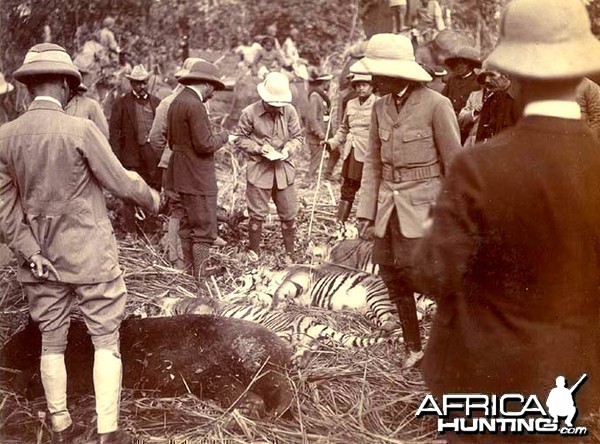
Hunters on foot count the kill - tigers and a bear. George V takes note of the number killed - 3-4 tigers and a bear. There were a total of 39 tigers and four bears killed during this hunt.
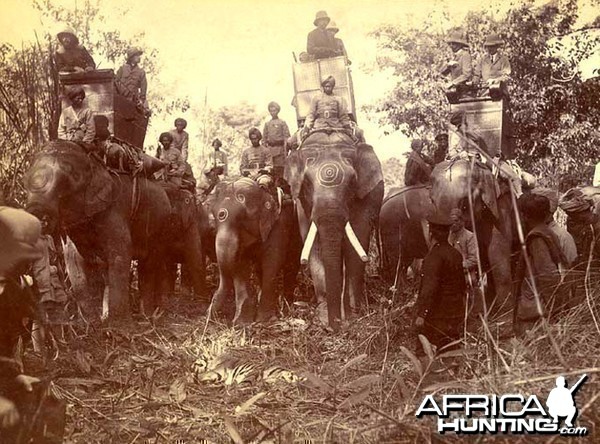
Hunting party on elephants with slain tiger. The "ring" is a method of hunting peculiar to Nepal. The hunters mounted on elephants form a "ring" and move in on their quarry, which has previously been stalked and enclosed in the area surrounded by the ring. There were a total of 39 tigers killed during this hunt. The Maharaja of Nepal stands in his howdah on the left, and George V stands in his in the centre.
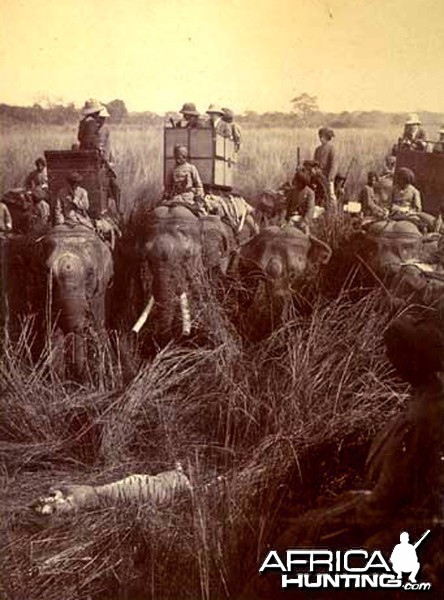
Hunting party on elephants with slain tiger. There were a total of 39 tigers killed during this hunt. George V is in the centre in his howdah, the Maharajah of Nepal is in the howdah on the left.
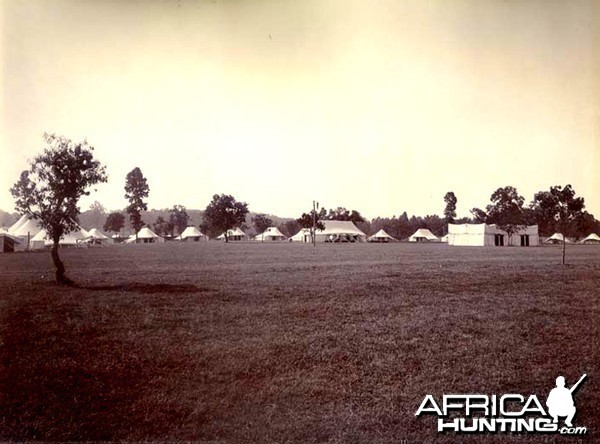
Camp of George V. George V's party used two camps during the trip. The first was at Sukhibar on the Rapti river where the party encamped for five days, then the party moved to a second camp at Kasra, some eight miles farther up the river for the remainder of the trip. The second camp duplicated the first. The Maharaja of Nepal was in a separate camp lower down on the Rapti river. His 14,000 followers camped hidden in the jungle behind.

Hunting party with George V and Maharaja of Nepal. This photograph appears in the album twice, on page 10 and on page 11.1/2he Maharaja is in his howdah on the left, and George V is in his on the right.
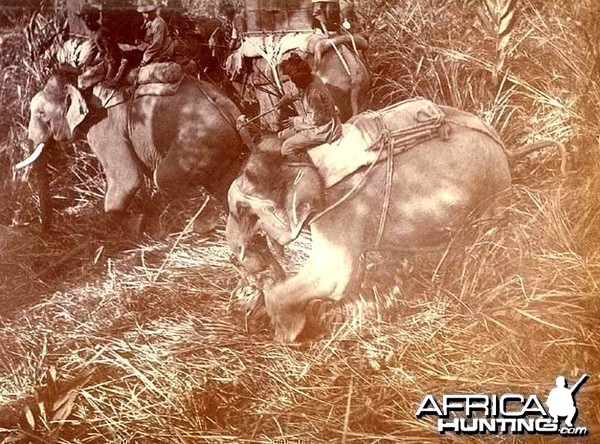
Elephant and mahout with tiger. The "ring" is a method of hunting peculiar to Nepal. The hunters mounted on elephants form a "ring" and move in on their quarry, which has previously been stalked and enclosed in the area surrounded by the ring. There were a total of 39 tigers killed during this hunt.

Hunting party on elephants, with George V. George V sits in his howdah in the centre. The young man in the howdah on the right appears to be holding a camera.

George V with hunting party on elephants. George V stands in his howdah holding his gun. The elephants in the background are forming a "ring". The "ring" is a method of hunting peculiar to Nepal. The hunters mounted on elephants form a "ring" and move in on their quarry, which has previously been stalked and enclosed in the area surrounded by the ring.
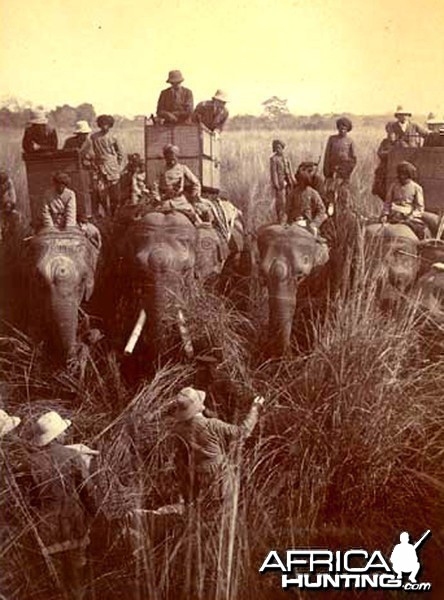
Hunters with quarry (tiger?). There were a total of 39 tigers killed during this hunt. George V stands in his howdah in the centre, the Maharaja of Nepal is in his howdah on the left.
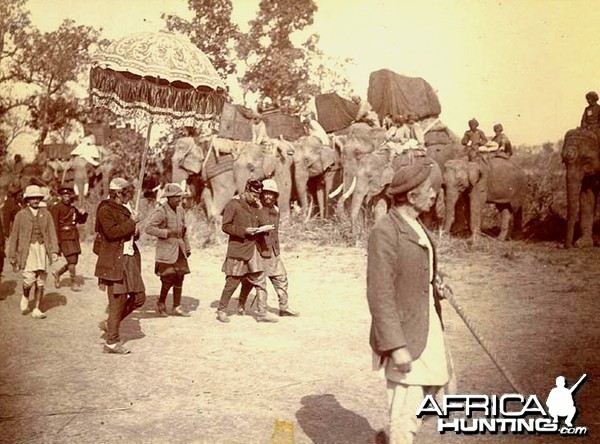
Maharaja of Nepal joining/leaving the hunt with escort. The Maharaja of Nepal walks with his attendants, one carrying a large decorated umbrella. Elephants and mahouts are waiting behind; some howdahs are covered.
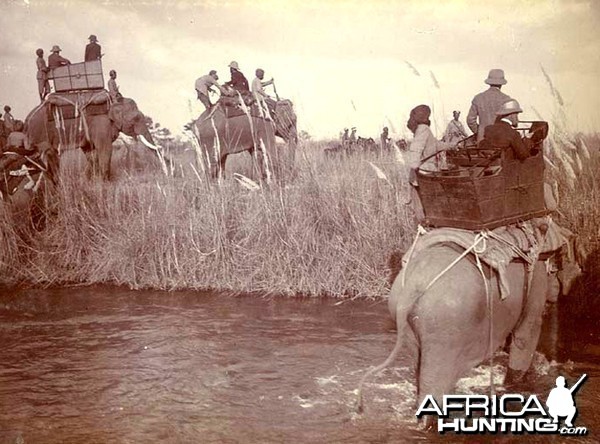
Hunting party on elephants crossing a stream. George V is in his howdah on the left.
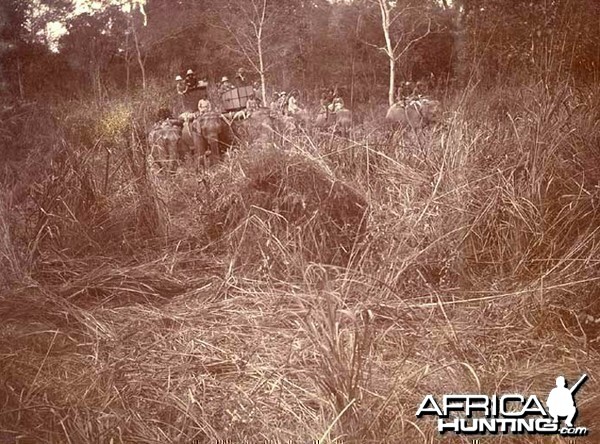
Hunting party on elephants, with George V and Maharaja of Nepal. The Maharaja and George V stand in their howdahs.
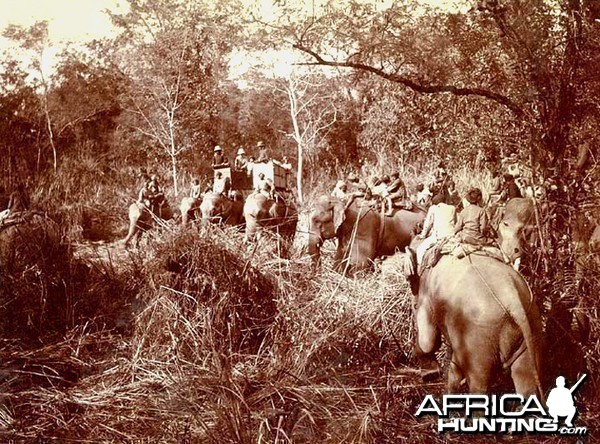
Hunting party with George V and Maharaja of Nepal. This photograph appears in the album twice, on page 10 and on page 11. The Maharaja is in his howdah on the left, and George V is in his on the right.
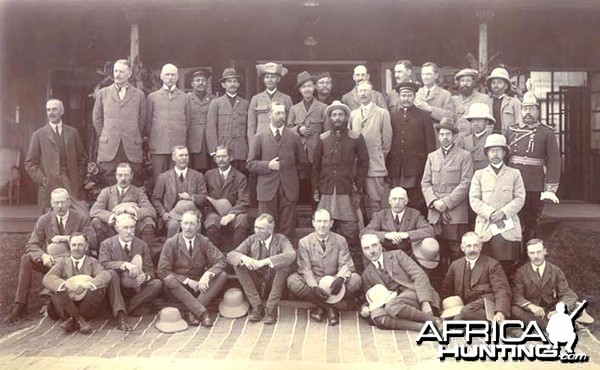
Hunting party poses in front of George V's bungalow. Group photograph of the hunting party in front of George V's bungalow. King George V with Chandra Shamsher Jang Bahadur Rana, Prime Minister and Maharaja of Nepal, stand in the centre.
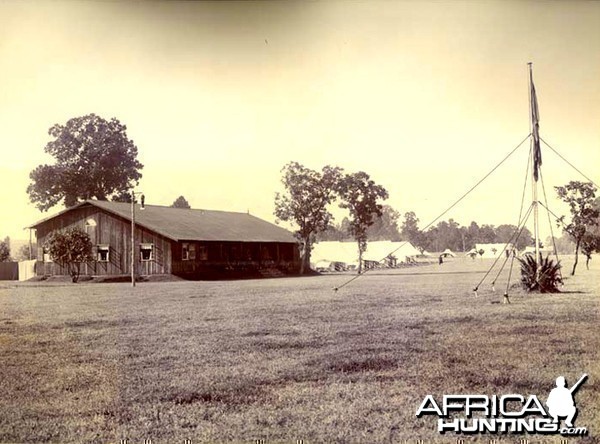
Camp, with George V's bungalow. George V's party used two camps during the trip. The first was at Sukhibar on the Rapti river where the party encamped for five days, then the party moved to a second camp at Kasra, some eight miles farther up the river for the remainder of the trip. The second camp duplicated the first. The bungalow, with electricity connected, was built especially for the King. The Maharaja of Nepal was in a separate camp lower down on the Rapti river. His 14,000 followers camped hidden in the jungle behind.
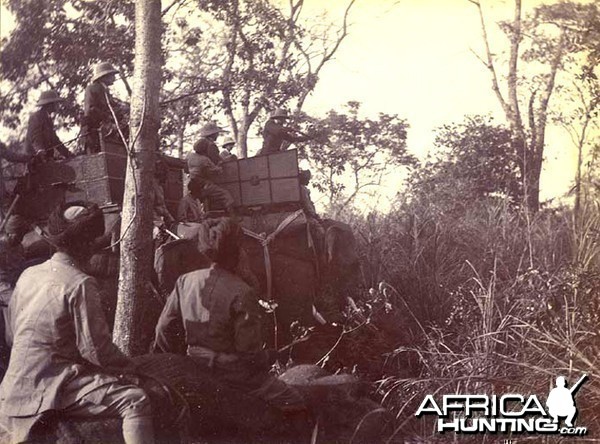
George V takes aim. George V stands in his howdah. Other members of the hunting party watch from behind.
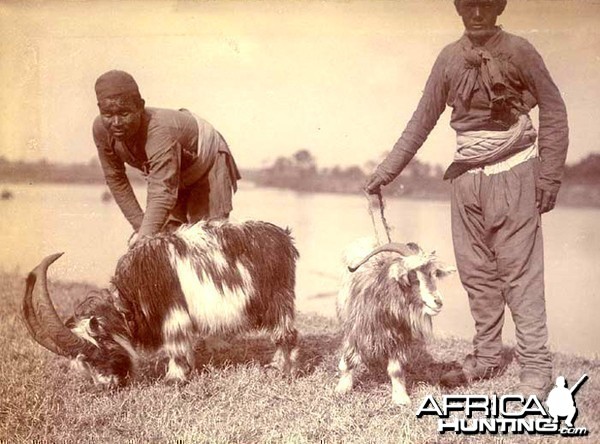
Goats with handlers on the banks of the Rapti. Possibly part of the gift of a "... collection of animals indigenous to Nepal which the Maharaja had presented to [King George V]. This collection consisted of over seventy varieties, ranging from a young elephant and a rhinoceros calf to the wild ass of the Tibetan border, also the rare shou, which [subsequently] with many others of the animals which survived the journey to England [could be found] in the gardens of the Zoological Society in London." - Historical record of the Imperial visit to India, 1911, p. 231.
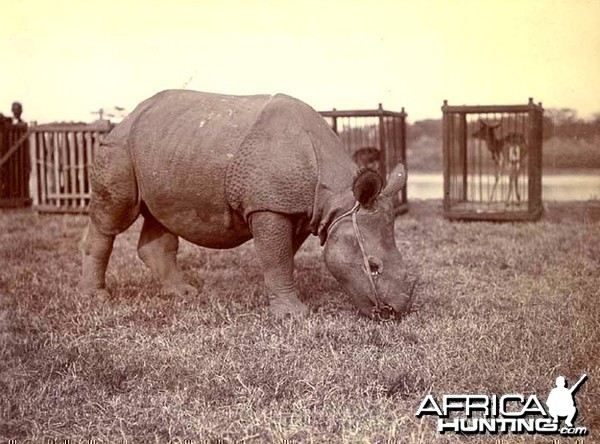
Tethered rhinoceros (Rhinoceros unicornis) with caged deer in the background. Possibly part of the gift of a 1c..... collection of animals indigenous to Nepal which the Maharaja had presented to [King George V]. This collection consisted of over seventy varieties, ranging from a young elephant and a rhinoceros calf to the wild ass of the Tibetan border, also the rare shou, which [subsequently] with many others of the animals which survived the journey to England [could be found] in the gardens of the Zoological Society in London. 1d Historical record of the Imperial visit to India, 1911, p.231.
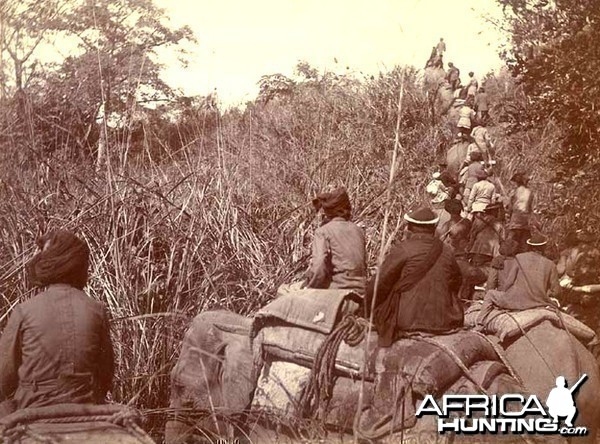
Mahouts (elephant handlers) and shikaris (hunters) on elephants forming a "ring". The "ring" is a method of hunting peculiar to Nepal. The hunters mounted on elephants form a "ring" and move in on their quarry, which has previously been stalked and enclosed in the area surrounded by the ring. "The [shooting] ring formed on [25th of December, 1911] was the largest during the whole visit, the number of elephants engaged being just under six hundred." Historical record of the Imperial visit to India, 1911, p.232.
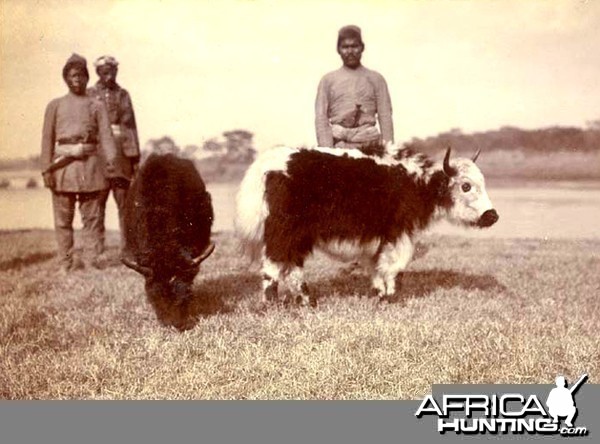
Yaks? with three Nepalis. Possibly part of the gift of a 1c..... collection of animals indigenous to Nepal which the Maharaja had presented to [King George V]. This collection consisted of over seventy varieties, ranging from a young elephant and a rhinoceros calf to the wild ass of the Tibetan border, also the rare shou, which [subsequently] with many others of the animals which survived the journey to England [could be found] in the gardens of the Zoological Society in London. 1d Historical record of the Imperial visit to India, 1911, p.231.
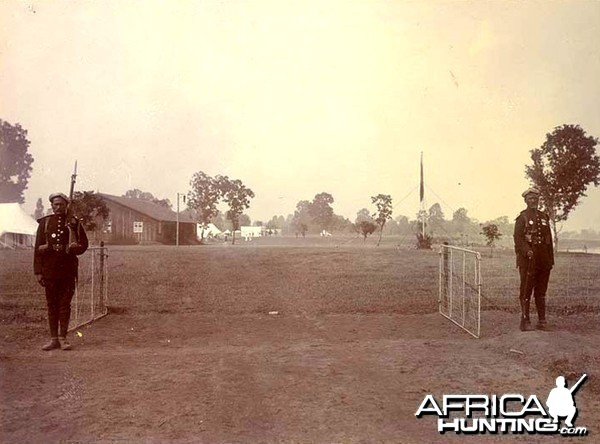
Sentries guard the gate to George V's camp. The bungalow, built especially for the King, is on the left. George V's party used two camps during the trip. The first was at Sukhibar on the Rapti river where the party encamped for five days, then the party moved to a second camp at Kasra, some eight miles farther up the river for the remainder of the trip. The second camp duplicated the first. The Maharaja of Nepal was in a separate camp lower down on the Rapti river. His 14,000 followers camped hidden in the jungle behind.

Bear... Possibly part of the gift of a " ... collection of animals indigenous to Nepal which the Maharaja had presented to [King George V]. This collection consisted of over seventy varieties, ranging from a young elephant and a rhinoceros calf to the wild ass of the Tibetan border, also the rare shou, which [subsequently] with many others of the animals which survived the journey to England [could be found] in the gardens of the Zoological Society in London." Historical record of the Imperial visit to India, 1911, p.231.

Hunters inspect four dead tigers and a deer. George V's elephant and howdah are on the left. There were a total of 39 tigers killed during this hunt.
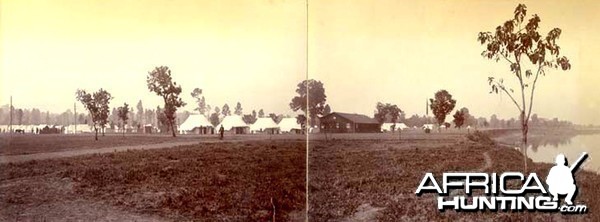
Camp, with George V's bungalow on the right. George V's party used two camps during the trip. The first was at Sukhibar on the Rapti river where the party encamped for five days, then the party moved to a second camp at Kasra, some eight miles farther up the river for the remainder of the trip. The second camp duplicated the first. The bungalow, with electricity connected, was built especially for the King. Electricity poles are on the left. The Maharaja of Nepal was in a separate camp lower down on the Rapti river. His 14,000 followers camped hidden in the jungle behind.
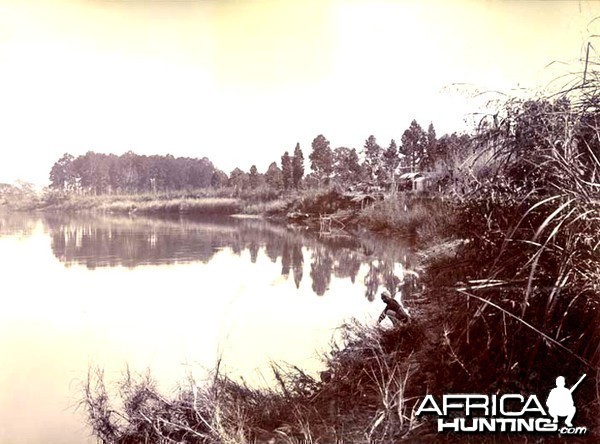
River with a Nepali and huts by the water's edge. River is probably the Rapti. The hunting parties camped on the banks of this river during the hunt.
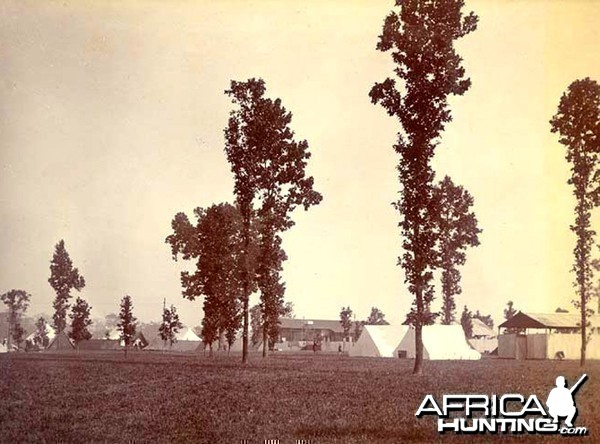
Camp, with rear of George V's bungalow. George V's party used two camps during the trip. The first was at Sukhibar on the Rapti river where the party encamped for five days, then the party moved to a second camp at Kasra, some eight miles farther up the river for the remainder of the trip. The second camp duplicated the first. The bungalow, with electricity connected, was built especially for the King. The Maharaja of Nepal was in a separate camp lower down on the Rapti river. His 14,000 followers camped hidden in the jungle behind.
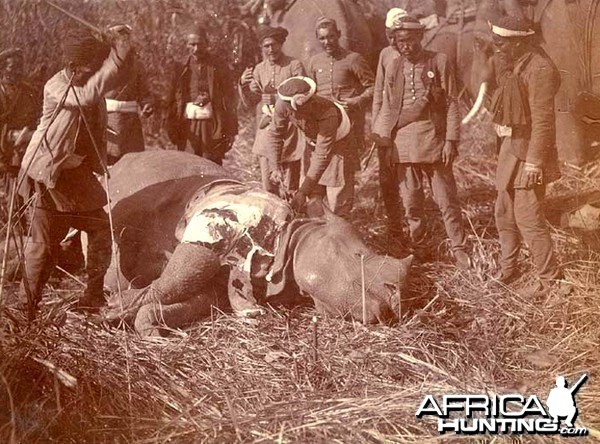
Shikari flays a dead rhinoceros. A group of men on foot watch as a dead rhinoceros is skinned and dismembered. There were a total of 18 rhinoceroses killed during this hunt.
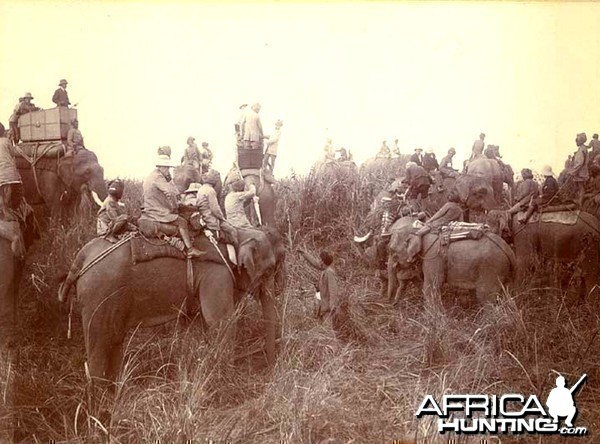
Hunters on elephants conferring in the field. George V stands in his howdah at the left.
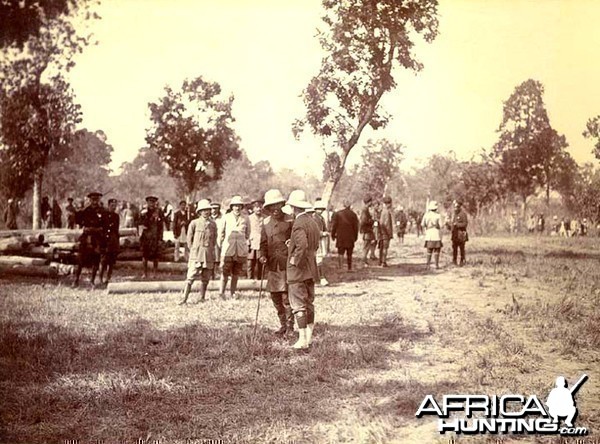
George V and the Maharaja consult on foot. Other members of George V's party, Nepali soldiers and shikaris are in the background.
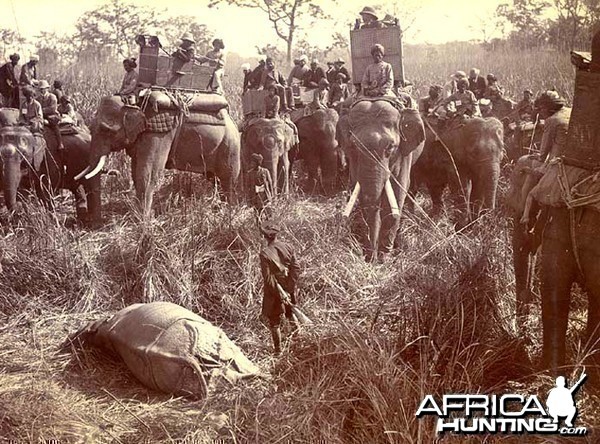
There were a total of 18 rhinoceroses killed during this hunt. George V sits in his howdah on the right, and the Maharaja of Nepal looks down from his howdah on the left.

George V mounts a seated elephant from the rear. The elephant has a pad but no howdah.
Background on The Terai and the Hunt
The Tarai region of Nepal is a narrow strip of flat land bordering India. Being part of the plain of the river Ganges, its southern area is very fertile agricultural land. Its northern part is marshy and abounds in wild animals. Today, part of this area forms the Royal Chitwan National Park, a Natural World Heritage Site. The Nepali Rana rulers had used this area as a royal hunting reserve from 1846 to 1951, and had maintained a good supply of game for themselves and their guests through the strict enforcement of game laws. "The forested areas of the Tarai are the home of tigers and leopards, gaurs (wild ox), occasional elephants and buffalo, and many deer … The Lesser Rapti Valley, in the Chitawan district, is one of the last homes of the great Indian rhinoceros (Rhinoceros unicornis)." (Encyclopaedia Britannica, s.v. Nepal).
Adrian Sever describes the King's shoot as follows: "An army of beaters was employed for weeks before the event to drive into a selected area all the big game that inhabited the warm damp jungles of the western Tarai . . . some forty points were selected within the area chosen for the shikar, and kills, usually goats, were tied up so as to establish the number and location of tigers and leopards. They were then hunted in uniquely Nepalese style. The tiger that was reported overnight from a kill was encircled by an enormous ring of elephants and held until dawn and the arrival of the guns. At times, as many as 250 elephants were employed for one circle. As the tiger approached, the ring was contracted until the great cat's escape was cut off. Upon the arrival of the visitors, ten or twelve specially trained elephants were introduced into the circle, which, in some cases was as much as 200 metres in diameter. These proceeded to form a line and march into the patch of jungle in which the tiger was hidden." Eventually, the tiger was flushed out. (Sever, pp.246-247)
Here is Olive Smythies, Ten thousand miles on elephants. London, Seeley Service, 1961, pp.149-153, detailed description of the style of big-game hunting in Nepal, and the method of using a ring of elephants:
Before attempting to describe a Maharaja's shoot, it will help the reader to visualize the scene if a description is first given of the method almost invariably used in all big shoots in Nepal, the famous and unique "Ring." This method is used only in Nepal, where it has been brought to an art, the highest pitch of perfection, and a most deadly method of killing all big game. There is in fact no other country in the world where the necessary factors for the "Ring" shoot exists, the enormous stud of shikar elephants, the trained experience and skill of their mahawats and the shikaris, the tremendous stretches of Terai forests, and the wonderful stock of tiger and rhino.
The natural home of tiger is the forest-clad foothills of of the Churia (Siwalik) range of the Himalayas, with the enclosed duns and valleys, and the adjoining forests of the flatter Terai. This great belt of tiger country stretches the whole length of Nepal, a distance of nearly 550 miles on the map, and for more than half the year it is deadly to man owing to the malignant Terai malaria. But from December to March it is a perfect paradise, with a glorious climate, wonderful scenery, and always to the north the incredible panorama of the eternal snows towering into the sky.
In this superb setting occur the big Nepal shoots to which many distinguished guests have been invited in cluding King George V. A wonderful organization is employed to ensure success. For weeks before the shoot commences, rough but serviceable motor roads and temporary bridges are constructed radiating out from the various jungle camps. All the jungle paths and streams and sandy river beds are examined to see where the tigers are, for in such places they leave their footmarks. A day or two before the shoot starts, young buffalo calves are tied up as bait, in scores or even hundreds, on every likely route a tiger may take. (The cow, being venerated, its progeny cannot be used for tiger bait.)
There are seven or eight groups of regularly appointed shikaris, each consisting of an officer (subedar), 10 or 12 subordinates, and two mounted soldiers for taking messages. Every group of shikaris has 10 to 15 buffalo calves (padahs) for tying up at suitable places. They live in temporary sheds in the jungle, primitive huts of wooden poles, leaves and jungle grasses fastened with strands of creepers, which they quickly erect with their kukris from the abundant material all around. Between them the various groups cover the whole tract of forest for miles around the central camp.
At dawn the shikaris go out and examine the padahs, tied out the previous evening. If, or when, one has been killed, they carefully examine pugmarks (footprints) to see if it is a big tiger or small, or one or several. They examine the drag and the direction taken. They then quietly proceed on foot and make a large circle of a quarter to a half mile diameter, demarcating the circumference with chipped stems and grass knots as they go, and are very careful to see that the drag has not gone beyond the circle. If it has, they make another one, as they must have the circle enclosing the end of the drag. This is called "cutting the circle" by the shikaris, and the final circle makes the future "Ring."
Meanwhile, as soon as it is seen that a padah has been killed and dragged, a special messenger mounts his horse, and gallops off to bring the news. Sometimes motor cars are parked at central spots to accelerate thedelivery of the message, and sometimes even a telephone line has been prepared and operators engaged to flash news to the camp.
Within a very short time the news has reached the camp from all directions whether and where there are kills, and the day's plan of campaign is discussed and settled. Immediately a great string of 200 or 300 elephants moves off in single file to the first kill, a few with howdahs, the majority with pads. The shooting party follows at leisure in cars as far as possible, and then on pad elephants.
The tiger or tigers have been approximately located by the shikaris from the direction of the drag, the nature of the cover for lying up, and the process of cutting the circle as already described. When the elephants arrive, they divide into two parties, which proceed very quietly in single file right and left along the line of the cut circle—and it is astonishing how quietly an elephant or line of elephants can move through the jungle. The rear elephants gradually drop out to take their stations at regular intervals, and finally the two leading elephants meet and the word is passed down both sides that the circuit is completed.
The shooting party mount the howdah elephants and the whole circle now moves inwards, crushing the grasses and shrubs, and the men on their backs shouting and whistling to drive the tiger towards the centre. The circumference of the circle of elephants gets smaller, until finally it is less than half a mile round, and the elephants get closer and closer until they are almost touching, and the tiger is surrounded by a solid wall of elephants. Then the order—stop the line—is shouted out and the ring is complete.
The stauncher elephants then move into the ring. Glimpses of one or more slinking forms are seen in the grass and undergrowth, when suddenly a tiger breaks cover and charges with a roar, to be met by shots from the rifle or shouts and missiles if he charges the ring. It is the moment of climax of a culminating excitement. Backwards and forwards he dashes striving to find an escape, to a pandemonium of men shouting and elephants trumpeting, grumbling and gurgling, thumping on the ground and, occasionally, when directly charged turning tail and bolting in terror.
It is necessary to emphasize that a tiger is not normally a dangerous animal and does not attack an elephant or a man, but once he feels cornered, he becomes a fighting mass of diabolical fury utterly fearless of man or elephant, whom he attacks in his mad rage without a moment's hesitation. He has been known to leap a height of 15 or 16 feet into a tall howdah, and more often than not a tiger will try to break through a ring by charging home on an elephant unless he is killed or crippled first by a well-directed shot.
It must also be realized that the Nepal Terai jungles with a fertile soil and rainfall of 100 inches are either gigantic grass growth, frequently the height of a howdah, or are a dense forest of trees, matted together with great climbers and a thick undergrowth of shrubs and shade-bearing plants in which, if an elephant bolts, it is almost inevitable that howdah and rider and mahawat and everything on the elephant's back will be swept with a crash to the ground by a thick branch or the loop of a tough climber. In either case it is extremely difficult to see a tiger at all until the area has been well trampled, by which time, naturally, the tiger or tigers are desperate and in a highly dangerous condition. "It is no sport for bad shots, hasty excitable people, or those with no stomach for danger. Even the most blasé hunter is likely to experience for a second or two a sudden spasm of fear when he first hears the blood-curdling roar of an infuriated tiger, and sees the great striped body launched in its charge, a thunder- bolt of death and anger in mid-air. It is one of the most terrific sights.in theworld." (Wentworth Day's King George Vas a Sportsman.)
Imagine what it must be like when, as frequently happens in the rings in Nepal, not one, but four or five and, once or twice, six tigers have been trapped simultaneously in one ring! The danger and heart-bursting excitement may continue for hours, until a succession of well-placed shots finally brings the thrill and nerve-tension to an end. That describes briefly typicaltiger shoot in the Nepal forests by the famous "Ring" method. Personally I never thought that this was a very sporting way of shooting tigers as they did not seem to have much chance of escaping with their lives.
King George V
King George V's reign began on 6 May, 1910. He was determined to visit India as soon as possible afer his coronation in London (22 June, 1911), in order to be crowned King/Emperor of India in Delhi. His advisors considered that an actual coronation ceremony was inappropriate, and suggested that he be presented as the crowned King/Emperor of India and receive the homage of the Indian Princes and rulers while he was seated upon his throne. This took place at a Durbar in Delhi on 12 December, 1911.
The King was passionate about shooting. After the Coronation Durbar in Delhi, he was looking forward to spending as much time as possible big-game shooting in Nepal. During his previous visit to India as Prince of Wales in 1905-1906, his planned shooting trip at the invitation of the Maharaja of Nepal had been cancelled due to an outbreak of cholera in the region. Before his 1911 visit, Maharaja Chandra Shamsher Jang Bahadur Rana, Prime Minister and ruler of Nepal from 1901-1929, had again invited him for a shoot in the Tarai region. Nepal's political power was held by the Rana family, which had instituted a system of hereditary Prime Ministers in the mid-19th century. The King of Nepal, who only held an honorary position, died a few days before King George V's planned trip, but had insisted before his death that the visit should not be cancelled.
The King travelled by train to Bhikna Thori in India, a few hundred metres from the border with Nepal. He proceeded by motor car to the first day's shooting ground. After about 20 kilometres, they reached the valley of the Rui river, from where they mounted elephants and proceeded into the forest. The king shot his first tiger while it leapt a small stream. That day the party killed four tigers and three rhinoceroses. The camp for the next five days was at Sukhibar, on a bend of the Rapti river, with the forest behind. "The river flowed past the camp in a broad and placid stream, forming a splendid foreground to the open jungle on the other bank, while occasionally in the distance a view could be caught of the snow-capped peaks of the Himalayas." (Historical record of the Imperial visit to India, 1911, p.230)
On 23 December, the camp moved to Kasra, eight miles farther up the river Rapti. The Maharaja's entourage, who were in a separate camp further along the river, numbered 14,000 including 2000 elephant attendants. After Divine Service on Sunday 24 December 1911, the Maharaja presented the King with a collection of over seventy varieties of animals indigenous to Nepal. During the hunting that followed Divine Service on 25 December, nearly 600 elephants formed the "ring". The King shot the largest tiger of the expedition on that day. On the last day of the visit, 28 December, the King reviewed a Brigade of four Nepalese regiments on his way to the hunting ground. The total number of animals killed during the hunting trip was 39 tigers, 18 rhinoceroses, and 4 bears. (Historical record of the Imperial visit to India, 1911, p.231-233)
The Album
The album consists of 16 pages and 50 photographs. It appears incomplete with the back cover missing. The front cover bears the company name Herzog & Higgins, Mhow (Central India) and the words "Bound at the Caxton Works, Bombay" inside the front cover. The album was discovered in a rural Indian home in Madhya Pradesh by the donor, Dr U.N. Bhati, Visiting Fellow, Economics and Marketing, School of Resources, Environment and Society at The Australian National University. The album was given to Dr Bhati by a distant relative who had worked for the former Maharaja and Maharani of Ratlam (in Madhya Pradesh), Mr and Mrs Parbinder Singh - who had given him the album.
About the Photographs
These 50 photographs depict scenes of the shikar, or hunt, the hunted animals and the hunting camps of King George V in the Tarai in December 1911. The photographs feature the wild animals of the Tarai including tigers, bears and rhinoceroses, the use of the elephant "hunting ring" technique, the activities of the mahouts (or elephant trainers/handlers) and shikaris (or hunters) as well as the various dignitaries involved in the visit. Each individual photograph has a pencilled number, but no caption. The captions have been supplied by the ANU Library.
Tiger lying in a stream. A tiger lies in a stream, with the ring of elephants in view in the background. The "ring" is a method of hunting peculiar to Nepal. The hunters mounted on elephants form a "ring" and move in on their quarry, which has previously been stalked and enclosed in the area surrounded by the ring. [On the first day of the hunt, 18th December] "... the first tiger [was] shot by His Majesty in mid-air as it was leaping a small stream." Historical record of the Imperial visit to India, 1911, p. 230.
Tiger. The tiger is camouflaged in the grassland. There are ominous shadows in the foreground.
George V with hunting party in the forest. George V stands in his howdah.
Hunting party inspects the head of a slain rhinoceros. There were a total of 18 rhinoceroses killed during this hunt.
Hunting party on elephants fording a river. River is probably the Rapti. The hunting parties camped on the banks of this river during the hunt.
Slain tiger. There were a total of 39 tigers killed during this hunt.
Hunting party on elephants fording a river. River is probably the Rapti. The hunting parties camped on the banks of this river during the hunt.
Hunting party on elephants fording a stream.
Hunting party on elephants at the edge of a river. River is probably the Rapti. The hunting parties camped on the banks of this river during the hunt.
Tiger crossing a stream. Historical record of the Imperial visit to India, 1911, p.230, notes that [on the first day of the hunt, 18th December] " ... the first tiger [was] shot by His Majesty in mid-air as it was leaping a small stream." There were a total of 39 tigers killed during this hunt.
Hunting party on elephants. The hunting party on elephants moves through long grass. King George V, on the right, is mounted on an elephant without a howdah.
Hunting party on elephants skirting a river. River is probably the Rapti. The hunting parties camped on the banks of this river during the hunt.
Hunting party with elephants. Members of George V's hunting party walk towards the waiting elephants and mahouts.
Slain tiger on the back of an elephant. Shikaris load a dead tiger onto the back of a seated elephant. There were a total of 39 tigers killed during this hunt.
Rhinoceros (and tiger?). Grassland with a rhinoceros at the left, and possibly a tiger at the bottom right.
Hunting party on elephants fording a river. River is probably the Rapti. The hunting parties camped on the banks of this river during the hunt.
Tigers running surrounded by the "ring" of elephants. The "ring" is a method of hunting peculiar to Nepal. The hunters mounted on elephants form a "ring" and move in on their quarry, which has previously been stalked and enclosed in the area surrounded by the ring.
Hunters on foot count the kill - tigers and a bear. George V takes note of the number killed - 3-4 tigers and a bear. There were a total of 39 tigers and four bears killed during this hunt.
Hunting party on elephants with slain tiger. The "ring" is a method of hunting peculiar to Nepal. The hunters mounted on elephants form a "ring" and move in on their quarry, which has previously been stalked and enclosed in the area surrounded by the ring. There were a total of 39 tigers killed during this hunt. The Maharaja of Nepal stands in his howdah on the left, and George V stands in his in the centre.
Hunting party on elephants with slain tiger. There were a total of 39 tigers killed during this hunt. George V is in the centre in his howdah, the Maharajah of Nepal is in the howdah on the left.
Camp of George V. George V's party used two camps during the trip. The first was at Sukhibar on the Rapti river where the party encamped for five days, then the party moved to a second camp at Kasra, some eight miles farther up the river for the remainder of the trip. The second camp duplicated the first. The Maharaja of Nepal was in a separate camp lower down on the Rapti river. His 14,000 followers camped hidden in the jungle behind.
Hunting party with George V and Maharaja of Nepal. This photograph appears in the album twice, on page 10 and on page 11.1/2he Maharaja is in his howdah on the left, and George V is in his on the right.
Elephant and mahout with tiger. The "ring" is a method of hunting peculiar to Nepal. The hunters mounted on elephants form a "ring" and move in on their quarry, which has previously been stalked and enclosed in the area surrounded by the ring. There were a total of 39 tigers killed during this hunt.
Hunting party on elephants, with George V. George V sits in his howdah in the centre. The young man in the howdah on the right appears to be holding a camera.
George V with hunting party on elephants. George V stands in his howdah holding his gun. The elephants in the background are forming a "ring". The "ring" is a method of hunting peculiar to Nepal. The hunters mounted on elephants form a "ring" and move in on their quarry, which has previously been stalked and enclosed in the area surrounded by the ring.
Hunters with quarry (tiger?). There were a total of 39 tigers killed during this hunt. George V stands in his howdah in the centre, the Maharaja of Nepal is in his howdah on the left.
Maharaja of Nepal joining/leaving the hunt with escort. The Maharaja of Nepal walks with his attendants, one carrying a large decorated umbrella. Elephants and mahouts are waiting behind; some howdahs are covered.
Hunting party on elephants crossing a stream. George V is in his howdah on the left.
Hunting party on elephants, with George V and Maharaja of Nepal. The Maharaja and George V stand in their howdahs.
Hunting party with George V and Maharaja of Nepal. This photograph appears in the album twice, on page 10 and on page 11. The Maharaja is in his howdah on the left, and George V is in his on the right.
Hunting party poses in front of George V's bungalow. Group photograph of the hunting party in front of George V's bungalow. King George V with Chandra Shamsher Jang Bahadur Rana, Prime Minister and Maharaja of Nepal, stand in the centre.
Camp, with George V's bungalow. George V's party used two camps during the trip. The first was at Sukhibar on the Rapti river where the party encamped for five days, then the party moved to a second camp at Kasra, some eight miles farther up the river for the remainder of the trip. The second camp duplicated the first. The bungalow, with electricity connected, was built especially for the King. The Maharaja of Nepal was in a separate camp lower down on the Rapti river. His 14,000 followers camped hidden in the jungle behind.
George V takes aim. George V stands in his howdah. Other members of the hunting party watch from behind.
Goats with handlers on the banks of the Rapti. Possibly part of the gift of a "... collection of animals indigenous to Nepal which the Maharaja had presented to [King George V]. This collection consisted of over seventy varieties, ranging from a young elephant and a rhinoceros calf to the wild ass of the Tibetan border, also the rare shou, which [subsequently] with many others of the animals which survived the journey to England [could be found] in the gardens of the Zoological Society in London." - Historical record of the Imperial visit to India, 1911, p. 231.
Tethered rhinoceros (Rhinoceros unicornis) with caged deer in the background. Possibly part of the gift of a 1c..... collection of animals indigenous to Nepal which the Maharaja had presented to [King George V]. This collection consisted of over seventy varieties, ranging from a young elephant and a rhinoceros calf to the wild ass of the Tibetan border, also the rare shou, which [subsequently] with many others of the animals which survived the journey to England [could be found] in the gardens of the Zoological Society in London. 1d Historical record of the Imperial visit to India, 1911, p.231.
Mahouts (elephant handlers) and shikaris (hunters) on elephants forming a "ring". The "ring" is a method of hunting peculiar to Nepal. The hunters mounted on elephants form a "ring" and move in on their quarry, which has previously been stalked and enclosed in the area surrounded by the ring. "The [shooting] ring formed on [25th of December, 1911] was the largest during the whole visit, the number of elephants engaged being just under six hundred." Historical record of the Imperial visit to India, 1911, p.232.
Yaks? with three Nepalis. Possibly part of the gift of a 1c..... collection of animals indigenous to Nepal which the Maharaja had presented to [King George V]. This collection consisted of over seventy varieties, ranging from a young elephant and a rhinoceros calf to the wild ass of the Tibetan border, also the rare shou, which [subsequently] with many others of the animals which survived the journey to England [could be found] in the gardens of the Zoological Society in London. 1d Historical record of the Imperial visit to India, 1911, p.231.
Sentries guard the gate to George V's camp. The bungalow, built especially for the King, is on the left. George V's party used two camps during the trip. The first was at Sukhibar on the Rapti river where the party encamped for five days, then the party moved to a second camp at Kasra, some eight miles farther up the river for the remainder of the trip. The second camp duplicated the first. The Maharaja of Nepal was in a separate camp lower down on the Rapti river. His 14,000 followers camped hidden in the jungle behind.
Bear... Possibly part of the gift of a " ... collection of animals indigenous to Nepal which the Maharaja had presented to [King George V]. This collection consisted of over seventy varieties, ranging from a young elephant and a rhinoceros calf to the wild ass of the Tibetan border, also the rare shou, which [subsequently] with many others of the animals which survived the journey to England [could be found] in the gardens of the Zoological Society in London." Historical record of the Imperial visit to India, 1911, p.231.
Hunters inspect four dead tigers and a deer. George V's elephant and howdah are on the left. There were a total of 39 tigers killed during this hunt.
Camp, with George V's bungalow on the right. George V's party used two camps during the trip. The first was at Sukhibar on the Rapti river where the party encamped for five days, then the party moved to a second camp at Kasra, some eight miles farther up the river for the remainder of the trip. The second camp duplicated the first. The bungalow, with electricity connected, was built especially for the King. Electricity poles are on the left. The Maharaja of Nepal was in a separate camp lower down on the Rapti river. His 14,000 followers camped hidden in the jungle behind.
River with a Nepali and huts by the water's edge. River is probably the Rapti. The hunting parties camped on the banks of this river during the hunt.
Camp, with rear of George V's bungalow. George V's party used two camps during the trip. The first was at Sukhibar on the Rapti river where the party encamped for five days, then the party moved to a second camp at Kasra, some eight miles farther up the river for the remainder of the trip. The second camp duplicated the first. The bungalow, with electricity connected, was built especially for the King. The Maharaja of Nepal was in a separate camp lower down on the Rapti river. His 14,000 followers camped hidden in the jungle behind.
Shikari flays a dead rhinoceros. A group of men on foot watch as a dead rhinoceros is skinned and dismembered. There were a total of 18 rhinoceroses killed during this hunt.
Hunters on elephants conferring in the field. George V stands in his howdah at the left.
George V and the Maharaja consult on foot. Other members of George V's party, Nepali soldiers and shikaris are in the background.
There were a total of 18 rhinoceroses killed during this hunt. George V sits in his howdah on the right, and the Maharaja of Nepal looks down from his howdah on the left.
George V mounts a seated elephant from the rear. The elephant has a pad but no howdah.
Background on The Terai and the Hunt
The Tarai region of Nepal is a narrow strip of flat land bordering India. Being part of the plain of the river Ganges, its southern area is very fertile agricultural land. Its northern part is marshy and abounds in wild animals. Today, part of this area forms the Royal Chitwan National Park, a Natural World Heritage Site. The Nepali Rana rulers had used this area as a royal hunting reserve from 1846 to 1951, and had maintained a good supply of game for themselves and their guests through the strict enforcement of game laws. "The forested areas of the Tarai are the home of tigers and leopards, gaurs (wild ox), occasional elephants and buffalo, and many deer … The Lesser Rapti Valley, in the Chitawan district, is one of the last homes of the great Indian rhinoceros (Rhinoceros unicornis)." (Encyclopaedia Britannica, s.v. Nepal).
Adrian Sever describes the King's shoot as follows: "An army of beaters was employed for weeks before the event to drive into a selected area all the big game that inhabited the warm damp jungles of the western Tarai . . . some forty points were selected within the area chosen for the shikar, and kills, usually goats, were tied up so as to establish the number and location of tigers and leopards. They were then hunted in uniquely Nepalese style. The tiger that was reported overnight from a kill was encircled by an enormous ring of elephants and held until dawn and the arrival of the guns. At times, as many as 250 elephants were employed for one circle. As the tiger approached, the ring was contracted until the great cat's escape was cut off. Upon the arrival of the visitors, ten or twelve specially trained elephants were introduced into the circle, which, in some cases was as much as 200 metres in diameter. These proceeded to form a line and march into the patch of jungle in which the tiger was hidden." Eventually, the tiger was flushed out. (Sever, pp.246-247)
Here is Olive Smythies, Ten thousand miles on elephants. London, Seeley Service, 1961, pp.149-153, detailed description of the style of big-game hunting in Nepal, and the method of using a ring of elephants:
Before attempting to describe a Maharaja's shoot, it will help the reader to visualize the scene if a description is first given of the method almost invariably used in all big shoots in Nepal, the famous and unique "Ring." This method is used only in Nepal, where it has been brought to an art, the highest pitch of perfection, and a most deadly method of killing all big game. There is in fact no other country in the world where the necessary factors for the "Ring" shoot exists, the enormous stud of shikar elephants, the trained experience and skill of their mahawats and the shikaris, the tremendous stretches of Terai forests, and the wonderful stock of tiger and rhino.
The natural home of tiger is the forest-clad foothills of of the Churia (Siwalik) range of the Himalayas, with the enclosed duns and valleys, and the adjoining forests of the flatter Terai. This great belt of tiger country stretches the whole length of Nepal, a distance of nearly 550 miles on the map, and for more than half the year it is deadly to man owing to the malignant Terai malaria. But from December to March it is a perfect paradise, with a glorious climate, wonderful scenery, and always to the north the incredible panorama of the eternal snows towering into the sky.
In this superb setting occur the big Nepal shoots to which many distinguished guests have been invited in cluding King George V. A wonderful organization is employed to ensure success. For weeks before the shoot commences, rough but serviceable motor roads and temporary bridges are constructed radiating out from the various jungle camps. All the jungle paths and streams and sandy river beds are examined to see where the tigers are, for in such places they leave their footmarks. A day or two before the shoot starts, young buffalo calves are tied up as bait, in scores or even hundreds, on every likely route a tiger may take. (The cow, being venerated, its progeny cannot be used for tiger bait.)
There are seven or eight groups of regularly appointed shikaris, each consisting of an officer (subedar), 10 or 12 subordinates, and two mounted soldiers for taking messages. Every group of shikaris has 10 to 15 buffalo calves (padahs) for tying up at suitable places. They live in temporary sheds in the jungle, primitive huts of wooden poles, leaves and jungle grasses fastened with strands of creepers, which they quickly erect with their kukris from the abundant material all around. Between them the various groups cover the whole tract of forest for miles around the central camp.
At dawn the shikaris go out and examine the padahs, tied out the previous evening. If, or when, one has been killed, they carefully examine pugmarks (footprints) to see if it is a big tiger or small, or one or several. They examine the drag and the direction taken. They then quietly proceed on foot and make a large circle of a quarter to a half mile diameter, demarcating the circumference with chipped stems and grass knots as they go, and are very careful to see that the drag has not gone beyond the circle. If it has, they make another one, as they must have the circle enclosing the end of the drag. This is called "cutting the circle" by the shikaris, and the final circle makes the future "Ring."
Meanwhile, as soon as it is seen that a padah has been killed and dragged, a special messenger mounts his horse, and gallops off to bring the news. Sometimes motor cars are parked at central spots to accelerate thedelivery of the message, and sometimes even a telephone line has been prepared and operators engaged to flash news to the camp.
Within a very short time the news has reached the camp from all directions whether and where there are kills, and the day's plan of campaign is discussed and settled. Immediately a great string of 200 or 300 elephants moves off in single file to the first kill, a few with howdahs, the majority with pads. The shooting party follows at leisure in cars as far as possible, and then on pad elephants.
The tiger or tigers have been approximately located by the shikaris from the direction of the drag, the nature of the cover for lying up, and the process of cutting the circle as already described. When the elephants arrive, they divide into two parties, which proceed very quietly in single file right and left along the line of the cut circle—and it is astonishing how quietly an elephant or line of elephants can move through the jungle. The rear elephants gradually drop out to take their stations at regular intervals, and finally the two leading elephants meet and the word is passed down both sides that the circuit is completed.
The shooting party mount the howdah elephants and the whole circle now moves inwards, crushing the grasses and shrubs, and the men on their backs shouting and whistling to drive the tiger towards the centre. The circumference of the circle of elephants gets smaller, until finally it is less than half a mile round, and the elephants get closer and closer until they are almost touching, and the tiger is surrounded by a solid wall of elephants. Then the order—stop the line—is shouted out and the ring is complete.
The stauncher elephants then move into the ring. Glimpses of one or more slinking forms are seen in the grass and undergrowth, when suddenly a tiger breaks cover and charges with a roar, to be met by shots from the rifle or shouts and missiles if he charges the ring. It is the moment of climax of a culminating excitement. Backwards and forwards he dashes striving to find an escape, to a pandemonium of men shouting and elephants trumpeting, grumbling and gurgling, thumping on the ground and, occasionally, when directly charged turning tail and bolting in terror.
It is necessary to emphasize that a tiger is not normally a dangerous animal and does not attack an elephant or a man, but once he feels cornered, he becomes a fighting mass of diabolical fury utterly fearless of man or elephant, whom he attacks in his mad rage without a moment's hesitation. He has been known to leap a height of 15 or 16 feet into a tall howdah, and more often than not a tiger will try to break through a ring by charging home on an elephant unless he is killed or crippled first by a well-directed shot.
It must also be realized that the Nepal Terai jungles with a fertile soil and rainfall of 100 inches are either gigantic grass growth, frequently the height of a howdah, or are a dense forest of trees, matted together with great climbers and a thick undergrowth of shrubs and shade-bearing plants in which, if an elephant bolts, it is almost inevitable that howdah and rider and mahawat and everything on the elephant's back will be swept with a crash to the ground by a thick branch or the loop of a tough climber. In either case it is extremely difficult to see a tiger at all until the area has been well trampled, by which time, naturally, the tiger or tigers are desperate and in a highly dangerous condition. "It is no sport for bad shots, hasty excitable people, or those with no stomach for danger. Even the most blasé hunter is likely to experience for a second or two a sudden spasm of fear when he first hears the blood-curdling roar of an infuriated tiger, and sees the great striped body launched in its charge, a thunder- bolt of death and anger in mid-air. It is one of the most terrific sights.in theworld." (Wentworth Day's King George Vas a Sportsman.)
Imagine what it must be like when, as frequently happens in the rings in Nepal, not one, but four or five and, once or twice, six tigers have been trapped simultaneously in one ring! The danger and heart-bursting excitement may continue for hours, until a succession of well-placed shots finally brings the thrill and nerve-tension to an end. That describes briefly typicaltiger shoot in the Nepal forests by the famous "Ring" method. Personally I never thought that this was a very sporting way of shooting tigers as they did not seem to have much chance of escaping with their lives.
King George V
King George V's reign began on 6 May, 1910. He was determined to visit India as soon as possible afer his coronation in London (22 June, 1911), in order to be crowned King/Emperor of India in Delhi. His advisors considered that an actual coronation ceremony was inappropriate, and suggested that he be presented as the crowned King/Emperor of India and receive the homage of the Indian Princes and rulers while he was seated upon his throne. This took place at a Durbar in Delhi on 12 December, 1911.
The King was passionate about shooting. After the Coronation Durbar in Delhi, he was looking forward to spending as much time as possible big-game shooting in Nepal. During his previous visit to India as Prince of Wales in 1905-1906, his planned shooting trip at the invitation of the Maharaja of Nepal had been cancelled due to an outbreak of cholera in the region. Before his 1911 visit, Maharaja Chandra Shamsher Jang Bahadur Rana, Prime Minister and ruler of Nepal from 1901-1929, had again invited him for a shoot in the Tarai region. Nepal's political power was held by the Rana family, which had instituted a system of hereditary Prime Ministers in the mid-19th century. The King of Nepal, who only held an honorary position, died a few days before King George V's planned trip, but had insisted before his death that the visit should not be cancelled.
The King travelled by train to Bhikna Thori in India, a few hundred metres from the border with Nepal. He proceeded by motor car to the first day's shooting ground. After about 20 kilometres, they reached the valley of the Rui river, from where they mounted elephants and proceeded into the forest. The king shot his first tiger while it leapt a small stream. That day the party killed four tigers and three rhinoceroses. The camp for the next five days was at Sukhibar, on a bend of the Rapti river, with the forest behind. "The river flowed past the camp in a broad and placid stream, forming a splendid foreground to the open jungle on the other bank, while occasionally in the distance a view could be caught of the snow-capped peaks of the Himalayas." (Historical record of the Imperial visit to India, 1911, p.230)
On 23 December, the camp moved to Kasra, eight miles farther up the river Rapti. The Maharaja's entourage, who were in a separate camp further along the river, numbered 14,000 including 2000 elephant attendants. After Divine Service on Sunday 24 December 1911, the Maharaja presented the King with a collection of over seventy varieties of animals indigenous to Nepal. During the hunting that followed Divine Service on 25 December, nearly 600 elephants formed the "ring". The King shot the largest tiger of the expedition on that day. On the last day of the visit, 28 December, the King reviewed a Brigade of four Nepalese regiments on his way to the hunting ground. The total number of animals killed during the hunting trip was 39 tigers, 18 rhinoceroses, and 4 bears. (Historical record of the Imperial visit to India, 1911, p.231-233)
Last edited by a moderator:
